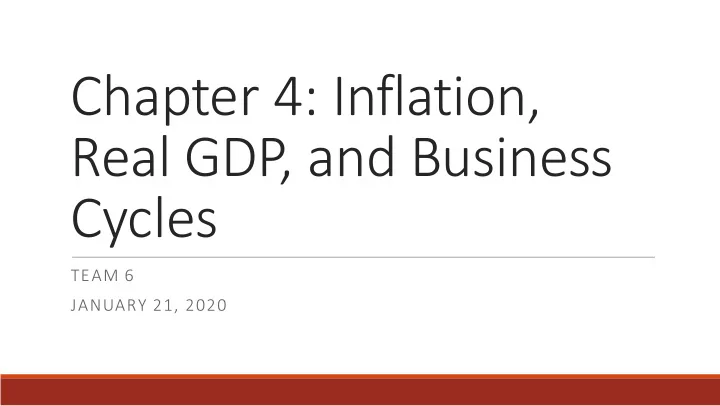

Chapter 4: Inflation, Real GDP, and Business Cycles TEAM 6 JANUARY 21, 2020
What is inflation? Consider a basket of goods in 1913 The cost of this basket is $100
What is inflation? Now consider the same basket a century later in 2013 This same basket of goods costs $2,363 ...THIS IS INFLATION!
What is inflation? Inflation is a sustained increase in the average price level. Inflation occurs when the percent weighted average of prices increases.
Measuring Inflation GDP Price Index Consumer Price Index Producer Price Index
• Hyperinflation occurs when a nation's price increase Hyperinflation above 50% per month for a sustained period of time Examples: • Revolutionary War - Continental Congress issued too many bills of credit to pay for the war • Post-World War I Germany - It was so bad that pickpockets would steal tissues rather than money
Example of Countries with Very High Inflation Rates, 1973-2008
• Deflation is when national price levels decline Deflation • Occurs when there are increases in the supply of all goods and services and/or reductions in demand
GDP=C+I+G+(X−M) Nominal GDP is the market value of all goods and services produced within a country during a given period using that year's prices, known as current prices. REAL GDP vs. Real GDP measures the output of a country by using constant NOMINAL GDP prices rather than the "current prices" used in nominal GDP. This takes away the effect of changes such as inflation and deflation. Adjusting nominal GDP to real GDP uses the GDP price index/GDP deflator as the "base year" prices.
• A recession occurs when there is a significant contraction in economic activity that is spread broadly across the economy and last more than a few months Business Cycles and How They're • An economic expansion occurs when broad-based economic Measured activity improves significantly and lasts for more than a few months • Business cycles are recurring, irregular, and • The entire business cycle can be measured peak to peak or unsystematic movements trough to trough in real economic activity around a long-term trend • To identify the phases, a nation must measure its real • No matter what nations economic activity → Based on Real GDP do to attempt to prevent economic downturn, they have always occurred
Exhibit 4-8: Recessions and Expansions During the Business Cycle
• These can be random shocks, that if anticipated and planned for could prevent dramatic changes in economic activity. Causes of • Production and spending patterns adjust as the economy reacts to the unexpected movements, and these adjustments work Business Cycles their way through the economy, causing cumulative changes in economic activity that are larger than the initial shock. • There is no single cause of business cycles. • Cash flows, being tied directly to companies’ top -line growth and costs can be sensitive to economic fluctuations. The cash • Business cycles can be flows of companies whose sales and or costs are tied closely to caused by supply-side or the business cycle are typically more volatilethan those that demand-side factors that are not. originate in domestic-based • A good example of a relatively high-risk industry is the durable or foreign-based real, goods (cars, furniture, phones, major appliances, etc.) industry because its sales are tied strongly to the business cycle. financial, political, and social sectors.
Exhibit 4-9 Procyclical, Countercyclical, and ndAcyclical MacroeconomicVariables • Procyclical variables – move in the same direction as the business cycle and economic activity • Countercyclical variables – move in the opposite direction • Acyclical variables – move independently from the business cycle
Business cycles are very hard to predict • Because changes in economic activity can be caused by a very broad range and combination of economic variables. • Predicting future economic activity, especially turning points, is also difficult because forecasts are usually extrapolations of historic trends, or they are based on historic interrelationships. • One way to forecast business cycles movements is by using a nation’s index of leading economic indicators ( LEI ), which help predict changes in business cycles and are chosen based on their economic significance, reliability, consistency, timeliness, and conformity to past business cycles.
Recommend
More recommend